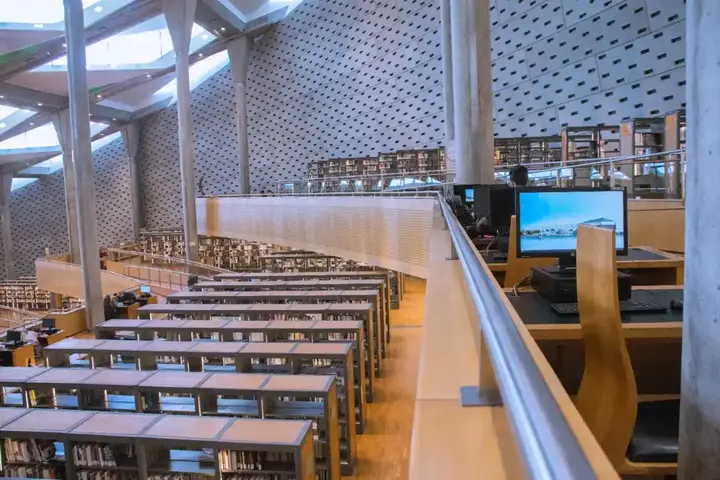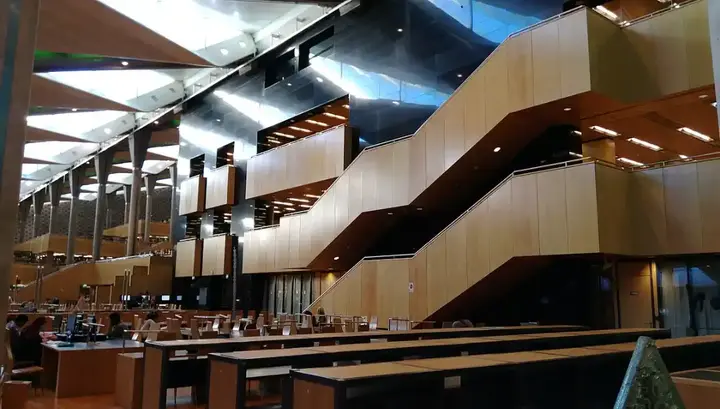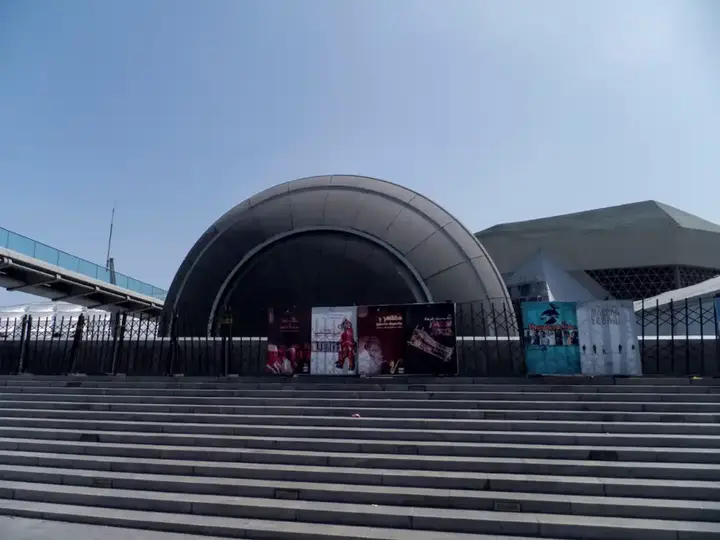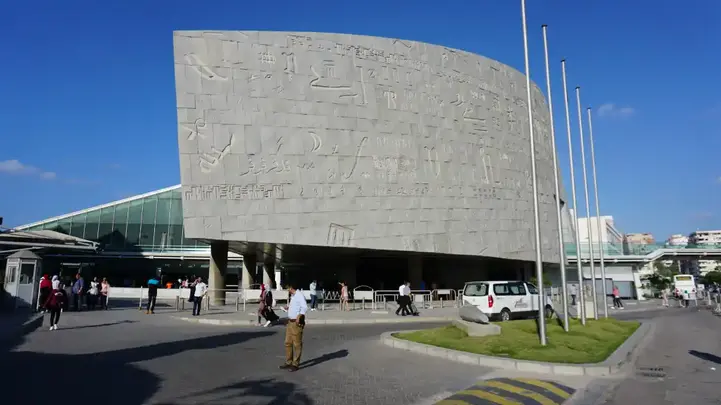A Journey into the History of the Bibliotheca Alexandrina: From its Precious Books to Its Creation and Unique Location

The Bibliotheca Alexandrina is considered one of the wonders of the ancient world, and one of the most famous and greatest libraries in history. In this article, we will learn how this library was established, what books and manuscripts it contained, and what importance and value it holds as a center of science, culture and education in ancient times.
Show key points
- The ancient Bibliotheca Alexandrina, established in the third century BC, was one of history’s greatest libraries and a symbol of global knowledge and culture.
- Initiated by Alexander the Great and developed by his Ptolemaic successors, the library aimed to collect all human knowledge in one location.
- It housed hundreds of thousands of manuscripts spanning various fields such as philosophy, science, literature, and religion, many collected from diverse regions and sources.
- ADVERTISEMENT
- The modern Bibliotheca Alexandrina, inaugurated in 2002 on the same site, serves as a cultural and scientific hub committed to reviving its ancient legacy.
- Strategically located on the Mediterranean coast, Alexandria’s historical and geographical significance enhances the library’s global role in connecting civilizations.
- The modern library features a digital archive, museums, and research centers, and hosts international events to promote education and intercultural dialogue.
- Despite the loss of the original manuscripts, the new library preserves their legacy through digital and printed copies sourced from institutions worldwide.
We will also learn about its geographical, historical and political location, and what events led to its establishment. Finally, we will discuss the role played by the current Bibliotheca Alexandrina, which stands tall on the shore of the Mediterranean Sea, in promoting communication and understanding among peoples and civilizations.
Recommend
The Bibliotheca Alexandrina: The Intellectual Foundation of the Library

What is the Bibliotheca Alexandrina?
The Bibliotheca Alexandrina is one of the most famous and greatest libraries in history, founded in the third century BC in Alexandria, Egypt. The library was a dream of Alexander the Great, who wanted to gather all the knowledge of the world in one place, and was able to achieve it by his Ptolemaic successors, who made it a global center of science, culture and education.
The library contained hundreds of thousands of books and manuscripts, covering various fields, languages and civilizations. The library also hosted many scientists, philosophers and writers, who contributed to the development and dissemination of knowledge.
The current Bibliotheca Alexandrina in Egypt is a cultural, scientific and educational project that aims to revive the spirit of the ancient library and keep pace with the modern era. It was created in 2002, on the same site as the old library, on the shore of the Mediterranean Sea. The current library includes a range of facilities and sections, such as:
• Digital asset repository.
• Manuscripts Center.
• Antiquities Museum.
• Center for Research and Studies.
The library organizes many activities and events, such as exhibitions, conferences, workshops, and seminars.
What was the importance of the library as a center of science, culture and education in ancient times?

The Bibliotheca Alexandrina was not just an ordinary library, but a landmark in the history of science, culture and education. Books and manuscripts from all over the world have gathered, covering topics ranging from philosophy and mathematics to poetry and religion.
In it work, learning and brilliance of many genius minds, which influenced human thinking and knowledge. It is where interaction and integration have been achieved among different civilizations, which have exchanged ideas and views. It reflected the culture and social influences of Alexandria, which was an open and plural city. Technology has been used and created to facilitate and improve ways of expression and communication. In it, she carried a universal message, calling for the search for truth, beauty and goodness.
What are the books and manuscripts included in the Bibliotheca Alexandrina and what are their sources and topics?

The Bibliotheca Alexandrina included rare and precious books and manuscripts, representing the scientific and cultural heritage of humanity. The sources of these books and manuscripts were diverse, some of which were locally produced by scholars and authors who worked in the library or visited it, some were imported from other countries, such as Greece, Persia, India and China, and some were sources from ships docked in the port of Alexandria, which were examined, copied and returned to their owners.
The subjects of these books and manuscripts covered all branches of science and knowledge, some related to philosophy, logic, rhetoric and literature, some related to mathematics, physics, astronomy, medicine and engineering, and some related to history, geography, genealogy, and religion.

The current Bibliotheca Alexandrina does not contain the original books and manuscripts that were in the old library, which were lost or destroyed due to wars, fires and earthquakes. But they contain digital and printed copies of some of these books and manuscripts, obtained from various sources, such as libraries, museums and scientific and cultural institutions in the world. The topics of these books and manuscripts vary between science, arts, literature, history, religion, and others.
Among the books and manuscripts currently included in the Bibliotheca Alexandrina, the following examples can be mentioned:
Euclid's Book of Elements, the most famous book on mathematics, a digital copy of which has been obtained from the Bibliothèque nationale de France.
Aristotle's Book of Animals, the first scientific book on biology, which classifies and describes animals, their parts and functions. A digital copy of it was obtained from the Vatican Library.
• The Book of Chemistry by Jabir bin Hayyan, the first book on chemistry, which deals with chemical processes, materials and experiments. A printed copy of it was obtained from the Cairo Library.
• The Book of the Thousand and One Nights, which is the most famous book in Arabic literature, which tells stories, folktales, fiction, and romance. A digital copy of it was obtained from the Library of Congress.
• Ibn Sina's The Canon of Medicine, the most comprehensive book on medicine, which combines Greek medicine, Islamic medicine and Indian medicine. A digital copy of it was obtained from the AUB Library.
The Establishment of the Bibliotheca Alexandrina: An Ambitious Project for Alexander the Great in the Past and for the State of Egypt in the Past

The establishment of the Bibliotheca Alexandrina is an ambitious project that reflects the vision and dream of Alexander the Great in ancient times and the state of Egypt in the present. Alexander the Great wanted to make Alexandria, which he founded in 331 BC, the capital of the United World under his rule, and a center of science, culture, and education.
For this purpose, he ordered the establishment of a great library containing all human knowledge, and collected books and manuscripts from all languages and civilizations. His Ptolemaic successors continued to implement this project, making the library the most important library in the ancient world, and a meeting place for scientists, philosophers and writers from all over. The library has been destroyed and burned several times, and most of its treasures and contents have been lost.
In the modern era, the State of Egypt has revived this ambitious project, establishing the new Bibliotheca Alexandrina on the same site as the old library, on the shore of the Mediterranean Sea. It was established in 2002, in cooperation with UNESCO, donor countries and international institutions.
The new library aims to restore the spirit of openness and research that characterized the old library, and keeps pace with the digital and information age. The Library promotes relations and cooperation with States and international and regional organizations, and promotes peace, dialogue and understanding among peoples and civilizations.
Where is the Bibliotheca Alexandrina: Strategic location on the shore of the Mediterranean Sea

The Bibliotheca Alexandrina is located in Alexandria, which is the second largest city in Egypt and the most important port on the Mediterranean Sea. The location of the Bibliotheca Alexandrina is determined by the following geographical, historical, and political factors:
• Geographical factors: The Bibliotheca Alexandrina benefits from its strategic location on the shore of the Mediterranean Sea, which connects three continents: Europe, Asia and Africa. It also benefits from its proximity to the Nile River, which is a source of water, fertility and life.
• Historical factors: The Bibliotheca Alexandrina is linked to the history of the city of Alexandria, which was founded by Alexander the Great in the fourth century BC, and which has witnessed throughout the ages different civilizations and cultures, such as Greek, Roman, Coptic and Islamic.
• Political factors: The Bibliotheca Alexandrina reflects the political situation of Egypt, which is considered an Arab, African and Mediterranean country, which plays an important role in the region and the world.
The Bibliotheca Alexandrina promotes relations and cooperation with countries and international and regional organizations, organizes many events, conferences and exhibitions, and provides services and projects to the local and international community. The Bibliotheca Alexandrina seeks to spread peace, dialogue and understanding among peoples and civilizations.

This was a tour of the history of the Bibliotheca Alexandrina, from its ancient books to its creation and unique location. We learned about the reasons and circumstances that led to its establishment in the past and its recent reconstruction. We explored the importance and value that the library holds as a center of science, culture and education in ancient and present times. We discussed the role played by the Bibliotheca Alexandrina in promoting communication and understanding among peoples and civilizations.
We hope that this article has added to your knowledge and culture, and has sparked your interest and curiosity with further learning and exploration. We invite you to visit the Bibliotheca Alexandrina and admire its treasures and beauty. We also invite you to share your opinions and comments on this article, and to express any questions or suggestions you have. Thank you for reading and following.








